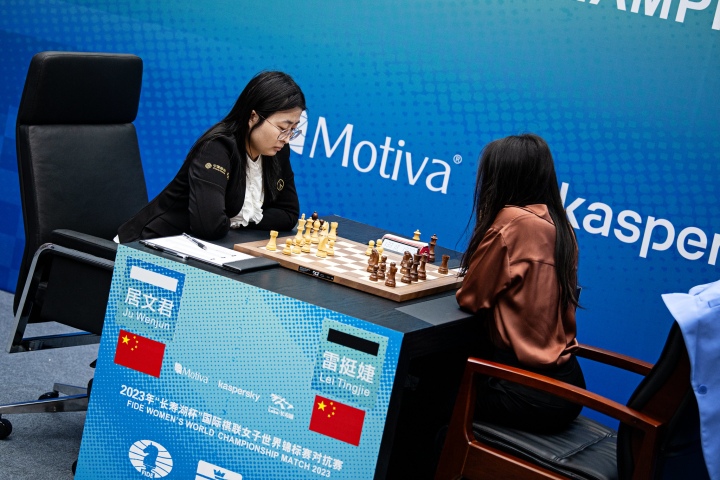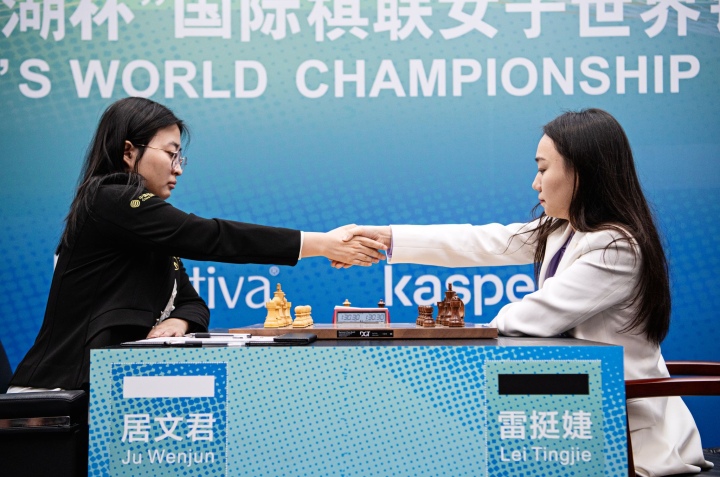All eyes on Baku as the chess elite descends on Azerbaijan for the World Cup

The event will feature an unprecedented prize fund of 2.5 million US dollars. For the first time, the top three players from both the Open and the Women’s section will qualify for the Candidates tournaments For nearly one whole month, the centre of the chess world will move to Baku, Azerbaijan. From 30 July to 24 August 2023, the Caucasus country will be host to the chess elite vying for the top places, qualifying for the 2024 Candidates tournaments. With an unprecedented prize fund of 2.5 million US dollars, the stakes are higher than ever before. Both the Open and the Women’s competitions of the World Cup will be held together at the same time. The format of the event was changed in the previous one (Sochi, 2021) by adding an extra round, which allowed to increase the Open section from 128 to 206 contestants. The Women’s section will feature 103 players. The 2023 event brings another change: instead of the top two, the top three players from each event will qualify for the forthcoming Candidates tournament, which will take place next April in Toronto, Canada. This event will be of special focus for Magnus Carlsen. The current World Number One rated player finished third in the previous tournament. Carlsen never won the World Cup, and he even never made it to the final – a surprising miss given that he has won everything else in chess there is to win. While this will be the tenth competition in the Open section, the event in Azerbaijan will only be the second event of its kind for women (the first one was in Sochi in 2021). Magnus Carlsen at the 2021 World Cup Photo: FIDE/Anastasiia Korolkova The frontrunners The 2021 decision to increase the number of players meant that the top seeds would be joining the event from Round 2. The list of top seeds features all the world’s best and strongest, save the current world champion, Ding Liren and the #6 on the July 2023 FIDE rating list Alireza Firouzja. The leaders in the Open section of its 10th jubilee event include Magnus Carlsen, Ian Nepomniachtchi, Fabiano Caruana, Hikaru Nakamura (who was granted a wild card), Anish Giri, Wesley So, Gukesh D and Maxime Vachier-Lagrave as well as the local favourites – Azerbaijan’s heavyweights and the top world players – the 2019 World Cup winner Teimour Radjabov and Shakhriyar Mamedyarov. Joining the star-studded lineup will be the defending champion Jan-Krzysztof Duda (pictured below). Having won the 2021 event, Duda will be looking to score a second victory. It has been achieved only once before – by Levon Aronian, who won the World Cup in 2006 and 2017. Photo: Eric Rosen Among the more seasoned participants, the event will feature the likes of Etienne Bacrot and the FIDE World Cup winners Boris Gelfand (2009) and Peter Svidler (2011, who was awarded a wild card for the 2023 event). At the time of writing, it is still unclear if the legendary Ukrainian player Vasyl Ivanchuk will attend, as he was denied permission to leave the country. The chess world has called on Ukrainian authorities to grant him an exemption – which you can read more about here. In the Women’s section, all eyes will be on Ju Wenjun, the reigning Women’s World Champion (pictured below), and the 2020 Candidate Aleksandra Goryachkina. They will face tough competition from former women’s world champions Alexandra Kosteniuk (who won the inaugural Women’s World Cup, in 2021), Tan Zhongyi, Mariya Muzychuk and Anna Ushenina, as well as top players such as Humpy Koneru, Kateryna Lagno, Anna Muzychuk, Nana Dzagnidze and others. Photo: David Llada The pairings and potential notable clashes With the pairings tree already published (here), some exciting match-ups can already be anticipated. Top seed Carlsen has a relatively straightforward path in the first two rounds before coming up against either the young German GM Vincent Keymer or the Iranian Amin Tabatabaei. Former World Rapid Champion Nodirbek Abdusattorov will likely face Anton Korobov, while Ivanchuk (assuming he plays) is going up against Wei Yi. The winner of the spectacular 2019 Isle of Man Grand Swiss, Wang Hao will clash with England’s David Howell, assuming both make it to the third round. Peter Svidler also has a relatively easy path to round three, where his biggest challenge is likely to be Jorden Van Foreest. Nepomniachtchi, Caruana, Nakamura, Duda, So and Vachier-Lagrave also seem to have a light task in the first two rounds. All attention in the women’s section will be riveted to the World Champion Ju Wenjun and 2020 candidate Aleksandra Goryachkina, who should not have too many difficulties in the first rounds. The other potential top match-ups in the Women’s section are likely to be Assaubayeva vs Paehtz, the Ukrainian face-off between Anna Muzychuk and Anna Ushenina, as well as a duel between Irina Krush and Polina Shuvalova. The best and only opportunity for many The forthcoming World Cup in Baku will be the only opportunity for many players to qualify for the Candidates and get a chance to vie for the prestigious World Championship crown. For the chess world, this will be the opportunity to witness some of the most unlikely match-ups, as lesser-known players from across the globe will have a chance to fight – and upset – the top world heavyweights. This unprecedented opportunity will ignite hope and a fighting spirit among the participants. But greatness awaits only a select few. About the event The FIDE World Cup has been held since 2005 and takes place every two years. The first Women’s World Cup was organised in 2021. The regulations for this year’s events, as well as the breakdown of the prize fund, can be found on the Official Information section of the event website: worldcup2023.fide.com/. For information about arrivals and accommodation, go here here.
The Queen of the chess world: Ju Wenjun defends Women’s World Championship title

Ju Wenjun (32) claimed her fourth Women’s World Champion title after clinching a crucial victory in the decisive, final, 12th game of the match against challenger Lei Tingjie With this victory, Ju has now equalled the record set by her compatriot Hou Yifan, both having won the world crown four times. Apart from defending the title, Ju also won €300,000 in prize money, while €200,000 went to the runner-up Lei Tingjie. Arkady Dvorkovich, the President of the International Chess Federation (FIDE) congratulated Ju on her victory: “To win a world crown is an amazing success, but to do it for a fourth consecutive time as Ju Wenjun did is something else. Congratulations to Ju for her victory but also to Lei for putting up a great fight. The chess world has another fantastic memorable event, and it was great to be a witness to it”. “This spectacular and tense match showed the best of women’s chess. The games played by the two Chinese players, the atmosphere and the excellent organisation of our Chinese hosts will be remembered”, Dvorkovich added. How the final game unfolded: This was the first time Ju Wenjun reached a final of a world championship match with a tied score – 5.5:5.5. In all three previous matches, she was either leading or trailing. Despite holding the world champion to a tie after 11 games, springing several surprises during the match and showing excellent opening preparation and tactical skills, the 26-year-old challenger Lei Tingjie cracked under pressure in the final round. Playing as White in what turned out to be the final game in the match, the defending World Champion Ju Wenjun punished her opponent’s errors in the middlegame to emerge significantly better. In the Queen’s Gambit Reversed Lei Tingjie opted for a lesser known line. Despite the position demanding Black plays more aggressively, Lei chose a more cautious approach. In an even position in the middlegame, Lei made a critical error after which White had a strong advantage. Luckily for Lei, the defending champion did not punish her but, instead, returned a mistake, by going for an exchange of material where White had a bishop and a knight for a pawn and a rook. Now Black was more comfortable. However, Lei’s luck ran out on move 22 when she made a positional blunder which gave the decisive advantage to White. This time, Ju executed a series of precise moves to secure victory. Following the exchange of queens, the two were in an endgame where Black had very weak pawns in the centre and no real counterplay. By move 29 she was in dire straits. As the world champion laid back in her seat, the challenger sank into deep thought, head in hand, realising this is the end. Following the famous chess quote that no one ever won a game by resigning, Lei fought on, hoping for a chance to make a comeback. Finally, on move 62, she had to resign. In all three games in this match that resulted in a victory, it was the player leading the white pieces who scored. Although she took the lead in the match in game five, Lei suffered a defeat in game eight after which her confidence somewhat cracked. In the final encounter of the match, she just fell apart in the middlegame. Despite this defeat, Lei Tingjie made history as one of the strongest challengers for the title of World Champion and is likely to make a comeback and fight for the crown again. Here follows a closer look at game 12 of the match: The first move in today’s game was made by Wang Yongquan, Deputy Director of the Standing Committee of Changshou District People’s Congress and Yang Shengyu, the President of Chongqing Chess Association. This game was the final chance for either side to make a push for the crown in the classical part of the match. The defending world champion Ju Wenjun was leading white pieces in her attempt to win the crown for the fourth time. As noted by Chinese Grandmaster Xu Yi, Ju Wenjun has never reached the final game of a world championship match with an even score! In the previous three matches, she was either leading or chasing the score by the final game. After 1.d4 d5 2.Nf3 Nf6 3.e3 Lei went for 3…c5 entering the Queen’s Gambit Reversed. With 4.dxc5 Ju took the most straightforward approach. An alternative was to play 4.c4 and offer an option to transition into different theoretical lines. The opponents quickly made a series of well-known moves. 4…e6 5.b4 a5 6.c3 axb4 7.cxb4 b6 8.Bb5+ Bd7 9.Bxd7 Nbxd7 10.a4 bxc5 11.b5 The position is roughly even. White has two passers on the a-and-b-files but slightly lags in development. Black is to develop the bishop and castle and is going to play in the centre and try holding White’s queenside advance. White will put her bishop on b2, on a powerful diagonal, aiming at the black king’s fortress. Wesley So has played this position three times with Black. He lost to Alireza Firouzja in 2020 but then won against Le Quang Lien and Bluebaum the following year. An interesting move for Black to consider here was 11… g5 to go for an extremely sharp game. 11…Qc7 A better place for the queen is on b8, as with being on c7, Black can lose a tempo if White manages to make a b6 push. 12.Bb2 Bd6 13.0-0 Black still had the opportunity to proceed here with the aggressive move 13…g5. In fact, 13… g5 was played in all the three previous games that reached that position – but they all ended in a draw. It seems that the position was inviting Black to play more aggressively or risk entering a slightly inferior game. Was this Ju Wenjun’s intention all along, assuming that Lei would not dare to play the gutsy moves like this one? 13…0-0 Lei played this move after 18 minutes of thinking. 14.Nbd2 Rfc8 14…e5 was considered a better move here for Black, increasing the pressure
Top players sign an open letter in support of GM Ivanchuk
Vasyl Ivanchuk at the World Team Chess Championship 2022 in Jerusalem Photo: FIDE / Mark Livshitz The FIDE World Cup will take place in Baku, Azerbaijan, from July 29 to August 25, 2023. The World Rapid Champion (2016) and four-time Olympiad gold-winner (1988, 1990, 2004 and 2010), Ukrainian Grandmaster Vasyl Ivanchuk received a wild card from FIDE to participate in this major competition. Vasyl Ivanchuk resides in Lviv, Ukraine. According to current legislation, he needs permission from the Ministry of Youth and Sports to leave the country for sports purposes as he is under the age of 60 (he is currently 54 years old). Such permission was not granted. The official request from the organizers of the World Cup, the Azerbaijan Chess Federation, was also declined. To address this situation, some of the world’s top Grandmasters signed an open letter to the Minister of Youth and Sport of Ukraine, Mr. Vadym Gutzeit. The signatories include Magnus Carlsen, Viswanathan Anand, Hikaru Nakamura, Fabiano Caruana, Wesley So, and Boris Gelfand. We are asking the chess community to support this motion by sharing the letter and hope that more Grandmasters will voice their support for GM Ivanchuk. Open letter in support of GM Ivanchuk (pdf)
FIDE seeks public discussion about proposed rating changes

One of the essential chess assets that FIDE is overseeing is FIDE ratings. Since adopting the Elo rating system in 1970, the rules and formulas for calculating ratings have undergone numerous changes, and the number of rated players has grown exponentially. In the past decade, certain innovations have caused rating deflation, a concern that has been raised by professional players and mathematicians and did not go unnoticed by FIDE. Players’ ratings are spread out too widely, and the situation is deteriorating with each passing year. The problem arises due to various factors, including the minimal rating being set too low at 1000 points, changes to the famous 400-point rule and the way the initial ratings are calculated. FIDE Qualification Commission and mathematician Jeff Sonas put significant effort into analysing the situation. As a result of this work, they propose two corrective measures. The first measure, which they called compression, aims to adjust for deflation. All players rated below 2000, which constitutes the bottom 85% of all rated players, shall be given a one-time rating increase on the January 2024 rating list. The additional points awarded will gradually decrease from 400 (for those rated 1000) to 0 for those rated 2000. For instance, a player with a rating of 1600 will receive an additional 160 points. The second measure, calculation improvements, focuses on improving the rating regulations to prevent future deflation. This includes raising the minimum rating from 1000 to 1400, restoring the 400-point rule to its earlier state so that it can apply multiple times in an event, and adjusting the formula for calculating initial ratings to incorporate two additional draws against hypothetical 1800-rated opponents. Understanding the significance of resolving the issue of rating deflation, we are sharing these proposals and inviting the chess community to engage in a public discussion. You can read the full text of Jeff Sonas’ suggestions here. We encourage the chess community to express their thoughts on this proposal and send us their comments, suggestions, ideas, and mathematical calculations. Please address your correspondence to Qualification Commission at qualification@fide.com until 30 September 2023. The Qualification Commission will thoroughly review all communication, analyse your suggestions, and present the final version of the rating regulation changes to the FIDE Council in October 2023. Once approved, the changes will be communicated to the public in December 2023 and will come into effect starting January 2024.
Third edition of Queens’ Festival goes big

Over 800 female players from 124 countries participated in the third edition of the Queens’ Online Chess Festival, a series of continental women’s online blitz tournaments that took place from July 2-16. The ambitious global project aiming at connecting women chess players from around the world was organized by FIDE Commission for Women’s Chess. The festival program included two competitions: Queens’ Women Open Tournament (all female participants with FIDE ID) and Unrated Princesses’ tournament (for girls without FIDE ID competing in U9 and U16 categories). The Queens’ Women Open Tournament saw the triumph of IM Deysi Cori from Peru, with WIM Nguyen Hong Anh and WGM Hoang Thi Bao Tram (both of Vietnam) finishing second and third, respectively. In the Unrated Princesses’ tournament, Melissa Wong from Malaysia scored 5 points and emerged as the winner in the U9 age category. Rajakaruna R M Sayuni Suhansa, with 4½ points and Lyayan Batyrova with 4 points, took second and third places, respectively. Medals in the older category – U16 girls – were won by Divya Bhavani Chembrolu from India (1st place, 7 points), Dariya Aukenova (2nd place, 5½ points) and Chetana Gopalakrishnan (3rd place, 4½ points). It is worth mentioning that refugee girls from FIDE’s “Chess for protection” project also took part in the Unrated Princesses’ tournament. Fifteen female students from Kenya, representing Angelina Jolie Primary School, Morneau Shepell Secondary School and Bhar-El-Naam Primary School, were competing in U9 and U16 categories. The main prize for the winners was really impressive! The winners of both events are invited to the 45th World Chess Olympiad 2024 in Budapest, Hungary. The ticket, full-board accommodation for 3 days and invitations to the Opening Ceremony of the Chess Olympiad 2024 for the winner and one accompanying person will be covered. In addition, the medal-winners and the top finishers in continental qualifications received training sessions with female grandmasters. “We believe that more chess tournaments for female players can bring lasting results to boost female participation in all aspects of chess life. Therefore we offer our winners training sessions with leading chess trainers as well as the chance to see the flagship FIDE event – the Chess Olympiad,” said the Chair of the FIDE WOM Commission, Anastasia Sorokina. The finals of the Queens’ Women Open Tournament and the Unrated Princesses’ tournaments were streamed live on the FIDE Youtube channel with expert commentary by WGM Anastasiya Karlovich and WIM Fiona Steil-Antoni. Link to the broadcast: youtu.be/72vbPHkL1A0
FIDE delegation visits China Qiyuan Hangzhou Branch

Chess will be part of the Hangzhou Asian Games 2023, to be held in the China Qiyuan, Hangzhou Branch. On July 17, Victor Bologan, FIDE Executive Director and Zhu Chen, FIDE Treasurer, visited the China Qiyuan Hangzhou Branch (Intelligence Building), and had a productive discussion with Hang Tianpeng, President of the China Qiyuan Hangzhou Branch, and Liu Xiao, head of the Intelligence and Sports Management Office of the China Qiyuan Hangzhou Branch. The sides exchanged views on future cooperation in promoting and developing chess projects. Both parties believe that the meeting was effective and beneficial and will become a starting point for future joint projects. The representatives of the FIDE stressed the importance of conducting mutually beneficial and win-win in-depth exchanges in promoting the standardization of international chess and industrial development. FIDE delegates highly praised the development of the intellectual sports and industry of the China Qiyuan Hangzhou Branch. Both sides had a frank exchange on their respective strengths, communicated intentions in regard to organizing and hosting chess competitions, conferences, and seminars, and expressed hope to deepen cooperation in the future. Also attending the meeting were Yu Ting, Deputy Director of the Intelligence and Sports Management Department of China Qiyuan Hangzhou Branch, Ma Yangchen, Executive President of China Chess Event Co., Ltd., and Du Qiang, General Manager of Hangzhou Qizhan Digital Technology Co., Ltd. In the afternoon of the same day, July 17, Secretary of Shaoxing Municipal Party Committee, Mr Wen, gave a friendly welcome to Zhu Chen, Victor Bologan, and Ma Yangchen. Mr Hu Min, Vice Mayor of Shaoxing, also attended the meeting. Mr Wen warmly greeted the FIDE delegation and told them about Shaoxing’s economic and social development, history and culture, as well as its achievements in preparing for the Hangzhou Asian Games and launching the chess game. According to him, chess has a solid competitive foundation in Shaoxing, cultivating a group of masters. He also expressed hope of FIDE’s continuing its support of Shaoxing’s chess sports, deepening cooperation in organizing events, and building up Shaoxing’s reputation as one of the chess strongholds in China. Zhu Chen complimented the vigorous development of Shaoxing chess in recent years, especially the successful hosting of several high-level competitions. Victor Bologan briefed on the relevant arrangements for FIDE’s 100th anniversary to be celebrated next year. He also noted that Shaoxing once held the “Belt and Road” Women’s Chess International Open and looked forward to launching other major chess projects in the city. Subsequently, both sides had in-depth exchanges on chess promotion and development in the future.
WWC Match 2023: Everything hangs on the final game

After game 11 of the match for the title of Women’s World Champion ended in a draw, the players are tied at 5.5:5.5. Everything now hinges on the final, 12th game of the match In a complicated and tense positional game, Lei Tingjie who was playing as White handed over some initiative to defending Women’s World Champion Ju Wenjun, but it wasn’t enough for a victory. This was the penultimate game in the classical part of the match, and it marked the last game where the challenger was playing as White. She opted for the Italian opening, the same one in which she scored a victory in game five – her only triumph over Ju in the match so far. Ju opted for a slightly different line than the one in game five. The two reached a dynamic position where Black had more spatial control. Lei tried to make progress by putting pressure on the e5 pawn, but Ju was countering well and gradually shoved White’s pieces back . After a lot of positional manoeuvering, White decided to transfer her king from the queenside to the kingside but gave her opponent some interesting options. Black launched a push in the centre after which she ended with a slightly better position. However, at the critical moment closer to the time control, instead of increasing the pressure by temporarily sacrificing the bishop, the defending Women’s World Champion decided to go for a series of exchanges, releasing the tension. In an even endgame that transpired, with queens and opposite-coloured bishops, the two agreed on a draw after 48 moves. The outcome of the match now hangs on game 12 where the defending World Champion will be White. If either side manages to win, they will take the crown. If that game ends in a draw, the title of the Women’s World Champion will be decided in a rapid tiebreaker. Game twelve will take place on Saturday, 22nd July, at 3 PM Local Time in Chongqing (GMT +8). Here follows a closer look at Game 11 of the match: As the two players sat across each other, Ju Wenjun was firmly looking at the chess board while Lei’s eyes went around the room. Each player had their own way of focusing. The first moves were made by Luo Jianping, Deputy Director of the Standing Committee of Changshou District People’s Congress and Yan Chunming, from the List of Good Samaritans of China. This was Lei’s last chance with white pieces against the defending Women’s World Champion. As in all of the previous games in the match where she played as White, she opened with 1.e4. Unlike game nine, in which she played the Sicilian, the World Champion returned to her main response move to 1.e4. After 2.Nf3 Nc6 3.Bc4 Ju opted for 3…Nf6, going into the Two Knights Defence. The two played a popular line in which White tried to take control over the d-square, but Black confidently countered this plan. Both sides have finished development and played very solid, not taking too many risks, noted Grandmaster Alik Gershon. Black has a strong knight on d5 and controls more of the centre, but White can put some pressure on the e5-pawn. The position is even. Both sides proceeded to align their rooks on the e-file and slowly arranged their pieces to optimal squares. Since the e5-pawn is well protected, White appears to run out of active options. Black, on the other hand, can regroup by moving her bishop to g7 and take more control over the center by f7-f5. After a long positional manoeuvring Ju got some spatial advantage and increased the initiative in the centre. Trying to strengthen her control over the e4-square, Lei played f2-f3 but weakened the dark squares in her camp. The position is complicated. Black is trying to force a push in the centre as White is trying to hold. White made a slight imprecision according to the engine: 33.Kf1?! with the idea of transferring her king to the queenside. Better was 33.Qe1, to reinforce the e-file defence. Here Black had a chance to make some progress by playing 33…Bg7 to prepare her dark-squared bishop shift to either f8 or h6, depending on the circumstances. If White sticks with her plan, then after 34.Ke1 Nf6 35.Kd1 Qd5 Black is clearly better. Instead, Ju played 33…Kg7. Now White’s king continued a long walk to the queenside while Black struck in the center and advanced her pawn to e3: 34.Ke1 Rh8 35.Kd1 e4 36.fxe4 fxe4 37.Kc1 e3 The key moment. White had a couple of safe options 37. Qg2 and 37. Qe1 but instead, the challenger took the pawn – 37.Nxe3. 37…Rhe8?! with this natural move Ju missed a chance to pose some problems for Lei with 37…Bg5! temporarily sacrificing a piece to pin the e3-knight and aim at the king on c1. White holds there, but it would not be that easy, especially closer to the time control. Instead, the line Ju chose led to a series of exchanges where the pressure eased off. Black regained the sacrificed pawn, but now the two were in an endgame with opposite-coloured bishops and no realistic winning chances for either side. The game ended soon afterwards, on move 48, following a threefold repetition. Both Ju and Lei are tied, 5.5:5.5. Everything now hangs on the final, 12th game of the match. If it ends in a draw, the two will proceed to rapid tiebreaks. Text: Milan Dinic Photos: Stev Bonhage Official website: womenworldchampionship.fide.com/ About the Match The match will take place in two Chinese cities, where each of the contestants comes from. The first half of the match will be in Shanghai, while the second half takes place in Chongqing. The match will consist of 12 games of classical chess. The payers will have 90 minutes for the first 40 moves, followed by 30 more minutes for the rest of the game, plus a 30-second increment per move starting on move one. Players cannot offer a draw before they reach the 41st move. In case of a tie,
FIDE turns 99

Today, July 20, 2023, we are celebrating our 99th birthday! Many of you across the world will celebrate International Chess Day with various activities and happenings all about our beloved game. On this day, we want to reinforce the tradition started in previous years: we ask members of the chess community to teach someone how to play chess. The more, the merrier! Be it your neighbour, niece, colleague or grandfather, let’s make the chess family grow. Don’t forget to share your experience on social media using the hashtag #Internationalchessday. Let’s make our celebrations really big and prove that chess is the most played game in the world! Why did the United Nations choose exactly July 20 to celebrate chess? It was done to mark the date of the International Chess Federation’s establishment in 1924, so it is also our birthday! Let’s briefly walk through our history and remember all the major milestones that lead us to this day. International Chess Federation, or shorter, FIDE (stands for Fédération Internationale des Échecs), is the governing body for the game of chess. What does FIDE do? It organizes major chess events, which form the World Championship Cycle, Chess Olympiads, Rapid and Blitz Championships, tournaments for people with disabilities, veterans, and children, as well as various exhibition and online events. It awards international chess titles, like the coveted Grandmaster, and calculates rating. FIDE creates and implements the rules of chess and standards for tournaments. It is actively involved in social projects and the promotion of chess on the grassroots level. FIDE is recognized by International Olympic Committee and includes as many as 199 national chess federations! Let’s have a closer look. FIDE was formed on July 20, 1924, in Paris, France, during the first unofficial Chess Olympiad. It was born at the Town Hall of the IX Arrondissement of Paris (6 Rue Drouot). Fifteen delegates from all over the world signed the proclamation act, and our organization was born. In 1927, FIDE organized the first Chess Olympiad and the first Women’s World Championship in London. In 1948, FIDE started overseeing the World Chess Championship. Today, both absolute and women’s chess crowns belong to players from China: Ding Liren and Ju Wenjun. In 1950, FIDE awarded its first Grandmaster title to 27 players. Today, FIDE titles also include International Master, Women’s Grandmaster, Women’s International Master, and lower-level ones like FIDE Master or FIDE Candidates Master. The first official FIDE rating list came out in 1971. This universal rating system, named after its creator Arpad Elo measures a player’s skill level and tracks their progress over time. New rating lists are out at the beginning of every month, and professionals and amateurs alike are eager to check the new numbers next to their surname. In 1999, FIDE was recognized by the International Olympic Committee – a major milestone in the organization’s history. The motto of FIDE is “Gens una sumus”, which translates from Latin as “We are one family”. This motto is a reflection of the organization’s vision of chess as a sport that unites people from all over the world. Family means care, and in recent years FIDE’s social projects have become an essential part of the organization’s operations. “Infinite Chess” project introduces the game to children with ASD, “Chess for Freedom” program brings chess behind the bars of prisons, “Chess for Protection” helps refugees find their way with the help of the game. FIDE financially supports its veterans in need and holds competitions for people with disabilities. The first Chess Olympiad for People with Disabilities took place in January-February 2023 in Belgrade. Chess has found its place in the ever-changing world of modern technology. Today, FIDE organizes online and hybrid events and implements new technological solutions. In 2023 chess became part of the Olympic Esports Series. Next year, FIDE will celebrate its 100-year birthday. The International Chess Federation has come a long way since its first steps a century ago. Today, it is based in Switzerland alongside other major sports governing bodies. It encompasses 199 national chess federations, which makes FIDE one of the largest sports federations in the world. Throughout its history, FIDE has been instrumental in shaping the world of chess, and we never stop aiming for new heights, serving the game and chess community.
ChessFest takes over London

The UK’s largest chess event took place on Sunday 16th July in London’s Trafalgar Square. Now in its third year, the annual open-air chess festival saw over 15,000 people attend the free event organised by the charity, Chess in Schools and Communities, to promote and raise awareness for the game we all love. After two previous years of scorching 30+ degree temperatures, the 2023 event took place under cooler conditions and thankfully remained rain-free, not that we’re convinced any of the 350+ chess boards would have been vacated for anything less than a deluge. The highlight of the day was the living chess displays which have been the centrepiece of previous events. With actors taking the place of the pieces, they re-enacted some of the best games played by UK players, with GM David Howell on hand to commentate on the re-enactment of his game against Ivan Sokolov from the 2009 Staunton Memorial. ChessFest also offered a “Challenge the Chess Master” where the masters had two and a half minutes to the public’s five, with prizes to those who managed a win or a draw. The number of masters steadily increased throughout the day from the scheduled four to nine to cope with the long queues that formed. It was a veritable “Who’s Who” of the chess world with GM David Howell, GM Gawain Jones, GM Luke McShane, GM Ravi Haria, GM Stuart Conquest, IM Andrew Martin, IM Harriet Hunt, IM Richard Palliser, IM Tom Rendle, IM Callum Kilpatrick, IM Malcolm Pein, WGM Katarzyna Toma, FM Tim Wall, FM Jonathan Pein and FM Akshaya Kalaiyalahan all taking turns. Even titled players, like GM Jonathan Roswon and IM Gavin Wall, who had turned up to spectate, were co-opted into pitching in! At the other end of the spectrum, one of the UK’s brightest prospects and the World U-8 Rapid & Blitz champion, Bodhana Sivanandan, challenged the USA’s own prodigy, 9-year old, Megan Paragua, in a match played live on the internet from Trafalgar Square and broadcast on the giant screen with commentary for the public. Although ahead in both games, Bodhana lost the match 0.5-1.5 but captained a team of London Juniors to a win in a match played against ChessFest Liverpool – who were having their own outdoor festival at Liverpool ONE – Chevasse Park. New for 2023 was the interactive chess puzzle competition organised by ChessKid starring the star of the online platform FunMaster Mike (FM Mike Klein). All children attending ChessFest were given new accounts to ChessKid and given 10 minutes to solve as many puzzles as possible on their mobile phones or devices. Hundreds took part, with the giant screen showing a live leaderboard. If the results are anything to go by, the future of UK junior chess is looking bright, with some awesome scores being recorded. To cap it off, Chess in Schools tutors were offering children and adults a free chess lesson in the “Teaching Zone”. Lessons ranged from how the pieces moved to the ultra-advanced nuances of the Accelerated Dragon. A total of 35 tutors provided close to 500 lessons throughout the day. ChessFest also took part in Nottingham on Saturday 15th July and in Hull on Sunday 16th July, with the juniors from Hull emerging victorious in their online challenge game against London. ChessFest will be back in 2024 and will be looking to build on this year’s success by bringing chess to more people across the UK. Text and photos: ChessFest official website
Ju and Lei still levelled as WWC Match 2023 enters final phase

The classical part of the match for the women’s world champion in chess is nearing its end, with only two more games left. The current score is 5:5 As the classical part of the match for the title of the women’s world champion in chess nears its end, the appetite for risk among players is falling. Game ten was a largely calm battle. Defending world champion Ju Wenjun opened with 1.Nf3, the same move she played in game eight when she defeated Lei. The challenger chose a slightly different response than the one in game eight, and, from an English Opening the two transitioned into a Queen’s gambit position. Despite a small imprecision by Ju in the opening, neither side managed to grab the initiative. Following exchanges in the middlegame, the two entered a drawn rook and queen endgame. Ju emerged a pawn up, but Black’s active pieces offered sufficient compensation. Soon, Lei regained a pawn and, by move 32, restored material equality. Soon Ju traded the queens and forced an even rook endgame. Despite both players being comfortable with splitting a point, neither could offer a draw before move 40. Soon, the 40th move threshold was passed, and the two happily shook hands. The close score is evidence of the high level of play exhibited by both competitors. Thursday, 19th July, is the final rest day of the match. Both sides will need to approach the rest day with more thought than any other rest day before: with just two more games for the final victory push, both need to be at their best. If the score remains tied after these games, the match will proceed to tiebreaks. Game eleven will take place on Friday, 21st July, at 3 PM Local Time in Chongqing (GMT +8). Here follows a closer look at game 10 of the match: With the score levelled and three more games to go (including today’s), it seemed that the defending World Champion had a slight advantage – she equalised the score in a critical moment to halt Lei’s surge and will be playing as white in two of the last three remaining games in the classical part of the match. By playing 1.Nf3 the defending champion opened with the same move as in game eight, when she defeated Lei. After some thought, Lei responded with 1…Nf6 and not 1…d5 as in game eight. In the press conference after game nine, the players we asked if they believed in superstition. While Ju’s reply was a firm “no”, Lei confirmed that she did. Whether this had any play in Lei’s opening move choice in today’s game is anyone’s guess. Ju wanted to avoid allowing Lei to enter the Tarrasch line, where the challenger had shown great skills in the previous games. Still, from the English Opening, the two gradually transitioned into a structure of the Queen’s Gambit where Black had the isolated d5-pawn – very similar to the Tarrasch Defence. Here Ju made a slight imprecision with 14.N2f3. It allowed White to play 14…Ne4 as Black aims to seize the initiative. Overall, during the match, Lei came across as better prepared in the openings. In all but one of the previous games, it was Lei who was better prepared in the openings and offering more surprises, noted Grandmaster Alik Gershon. 15.Nd2 “The world champion shows great character by admitting and fixing her mistake on the very next move with 15. Nd2!”, said Grandmaster Alik Gershon. Still, Ju lost a tempo. Here Lei spent 20 minutes thinking about what to do next. She had three options: To take on d4 and follow a line of exchanges or, place her knight on g5 and keep the pressure on the e4-square. The third option was 15…Qf6, with the idea of placing the queen of h6 and making mating threats on the white king as well as pinning the e3-square for some potential tactics. After she finished calculating the lines, Lei went for the most straight-forward, 15…Nxd4, and then tried to transfer her rook to the kingside via Re6-g6 (h6). However, Ju was on her guard and thwarted this plan. Here a series of exchanges followed, pushing the game towards a draw. 18.Nxe4 Bxd4 19.Qxd4 Rxe4 20.Qxd5 Rxe3. An interesting moment occurred here when Ju started laughing. Despite trying to be discrete about it, it was noticeable to Lei and the audience. In the press conference, Ju explained that “something came to my mind, not about chess… Then I just couldn’t stop laughing”. This was not taken as a bad thing by Lei. 21.Bc4 Re7 22.Qxb7 Bb5 23.Qd5 Following the sequence of natural moves, the opponents reached a roughly equal position despite Black being a pawn down. Still, Lei was the one who needed to play more precisely here. Grandmaster Xu Yi – who knows both players well as he played with them in the Chinese leagues – noted that Lei “needs to be careful here, especially when playing against Ju”, hinting at the world champion’s preference to try and squeeze a victory out of a tiny advantage. A few moves down the road, the bishops were off the board, and the two entered queen and rook endgame. Ju’s extra pawn on c4 is exposed to attack, while Black’s pieces are very active. Soon the c4-pawn fell, and Ju forced an exchange of queens leading to a dead-even rook endgame. Although it was a draw, the two could not offer it to one another before move 40, as per regulations. The two played until move 47 and decided to call it a day. On routines and rankings The press conference after game 10 yielded some notable comments from the players about their routines and preparation. While both were unwilling to say anything more than the ordinary about their daily habits, they did reveal one interesting detail. When asked by the Chinese Woman Grandmaster Gu Xiaobing how many hours of sleep they get, Ju said she sleeps about eight hours a day, while Lei revealed that she sleeps as much

